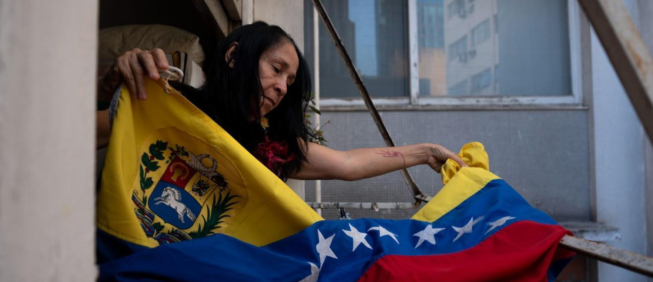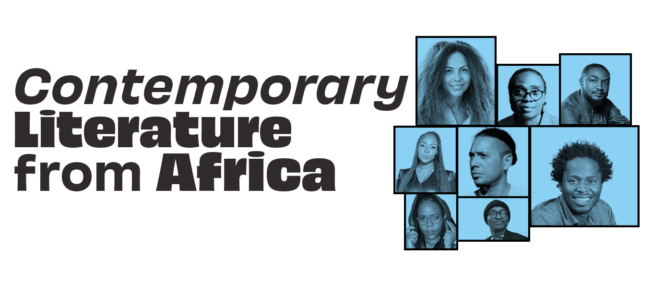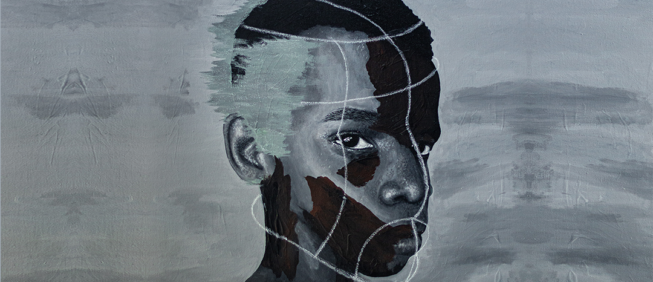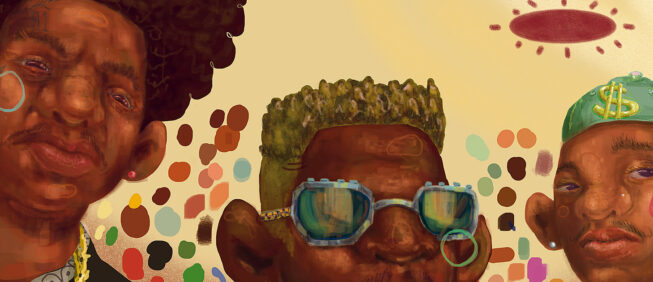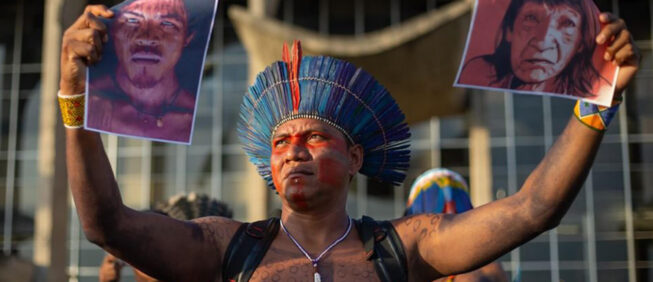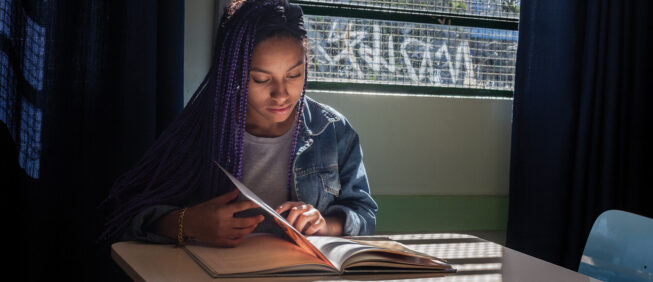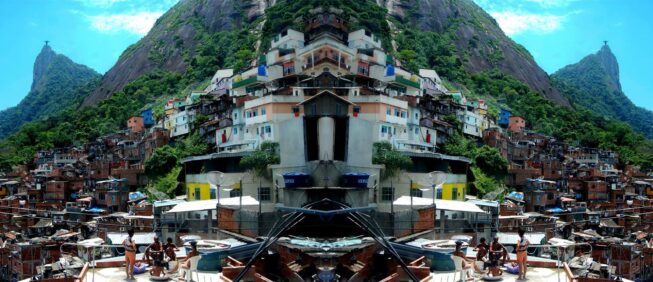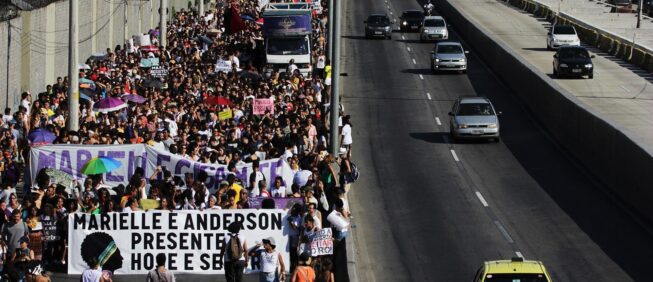Ailton Krenak — The Potency of the Collective Subject
part 2
by Jailson de Souza e Silva
| Brazil |
May, 2018
translated by Daniel Martins de Araújo
the time of the myth
Ailton Krenak: It is a completely absurd myth to say that we, the indigenous, alongside the black people, forcibly brought from Africa and thrown here, and the white people, some of them coming without knowing what the destination was, came to constitute the base of our civilization. This is a complete cheapening of our history, it is a denial of the profound conflicts that marked these people's mismatches. To naturalize the encounter of the indigenous and black people in the quilombo, as a fact that emerges as a representation of force, of natural alliance of these people against their oppressor, is also a mystification, because once the black and indigenous built up alliances, there was a huge capacity for alterity in the quilombo. Identities were so clear that there was no pot whatsoever, no cauldron to mix them all together, from which to take an extract. So people knew they were not raw material, they are human beings with biographies, lives and histories. Their societies had their own trajectories, they had a circumstantial alliance against the oppressor. But they were not creating a new civilization; this mystification is just a way for our continuing rulers to explain and justify the type of history we are making in the long-term.
"The best way to write down Brazil’s history in an edifying manner is by saying that even though indigenous and black people were being flayed and mortified, still, they raised the flag of brazility"
Although whites cracked the whip on blacks and indigenous, those indigenous and blacks were so Christian, so compassionate and devoted that they were raising the Brazilian flag written “order and progress.” So it is a completely conned and mystifying epic of our formation.
At the base our formation there is only conflict; neither did the whites come here to conduct any edifying act, nor did the blacks come here voluntarily to be slaves, nor were the indigenous people here having fun with that whole invasion.
Such a strong invasion does not stop, and relies on many collaborators from the inside. When so many dress in green and yellow t-shirts and yell along Paulista Avenue, following a inflatable duck, they are showing us that those resisting are fewer than those collaborating. There are many more collaborators saying: “come and get us” than people rising up and saying: “do not come, because there is a people living here." Still, it demonstrates a lack of identity. For me this was the largest claim, that we still need to walk a long way in order to look each other in the eye someday and say: “somehow we constitute a nation.” I am still incredulous about a possible Brazilian nation, a kind of a difficulty that has followed me since earlier times when I refused join any political party. I have never been affiliated with any political party, simply because I didn’t fit into any of their baskets. There was a rebel guy from the State of Goiás, who helped me to create the Indigenous Research Center… when he was angry, he used to say: “don't try to force me into a basket.” It was how he rebelled. I think this was always a type of motto for me, because the consoling idea that we are in the bosom of a nation, never excited me. I have always felt distressed with the feeling that we are a huge camp in the dark, most of the time knocking down one another.
Sometimes we feel a flash, and that short moment of illumination makes us look around and say: “there are the indigenous people, here are the black people, and over there are all those other peoples who came here." This camp is filled with this multitude, all of these peoples and worlds are here. In this short glimpse of each other, we mobilized the “direct elections now” movement in 1984, we conducted a constitutional convention campaign in 1988; but we are once again back in the dark, brawling with each other. Only when the lights are on once again do you look and see each other half flayed, broken.
How can you call such a thing a nation? So it is a camp of the remaining Portuguese, indigenous peoples, some Africans and others African-descendants, since people from Africa are still coming here, though this time they are not forcibly brought here, but they are rather coming to continue with their lives and experiences, their struggles and engagements, their history, so it comes back to life.
Likewise as indigenous people are revived upon contact with our relatives who still live under favorable conditions in the forest, these visitors who come from Africa also revive the thoughts of many black thinkers here in Brazil in regards to who we are. We cannot be lost in a camp in which we only acknowledge each other when a flash strikes, we must be capable of trying to maintain a continuing memory of who we are.
In the indigenous people’s case, the continuing memory must visit a place they insist calling myth, because they want it empty of historical sense, so they call it myth.
The thing is that all mythic narratives speak of things that we live, recognized as history. The other day I thought to myself, what is this place that myth reports to you? How does a thought sustain itself in this place of the myth's narrative, so as to think and interact with the world? It occurred to me that in the time of the myth we had not yet felt the anguish of certainty. It sounds like a philosophical debate, right? The time of the myth is when you still do not feel the anguish of certainty. You must not be sure; the myth is a possibility, not a guarantee. There is no length or time guarantee; it is magical. It inaugurates, opens a door for you to cross and travel the world, interact and find fulfillment in the world. It is always, obligatorily, a collective experience. It is not the subject, not the self-made man. There is no self-made man in this history. People belong to their collective, their histories are marked by a profound interaction with a constellation of people who, often have their cultural heritage at their base – their grandparents, their ancestors. Regardless of what they worship, the most ancient and ancestral memories lie at the core of their mindsets, in the way they position themselves in the world.
education
Ailton Krenak: I think we find an interesting point of intersection with Macaé’s1Macaé Maria Evaristo dos Santos is an educator -- she coordinated the Program of Implantation of Indigenous Schools in the state of Minas Gerais from 1997 to 2003. She acted as Secretary of Literacy, Diversity and Inclusion in the Ministry of Education from 2013 to 2014. biography, in her ability to connect [the time of the myth] with the idea of education. Her experience with education is a supercritical appropriation, less than a tool and more than an environment in which the modern world’s social life constitutes itself.
It is in the field of education, it is when you start to fabricate the subject, to build the person. In the case of traditional societies of orality, the person starts to be constituted even earlier, in the dream, before being in the mother’s belly. Many of these persons are dreamed, and when the mother starts gestation, the family, the collective, already knows that the child has come, and who is coming. So different traditions know that an elder is coming. When the boy is born, they know how to look at him and say: “this is that guy we knew, or this is so-and so.” This has nothing to do with reincarnation, it has to do with other much more complex things. But it is the capacity to understand the flow, the long journey of human experience that interacts with those who are alive and the ancestors, regardless of religion. You can even be evangelical. Because people might say: “no, but this is a thing of the pajés, shamans, and candomblés.” No, no matter the memory people have, deep memory is formed by the ancestors.
Then once you think about a type of society in which the subject's engagement in society is provided by this formative process that we can call education, then I get highly interested by how Macaé acts, what her focus is. It differs from Paulo Freire. Darcy Ribeiro is also a vein of education, but his education’s perspective, and how other educators and thinkers treat education as a service and competence of the State, in which it has hegemony to run and organize this process, to….
Jailson de Souza e Silva: To define an agenda?
Ailton Krenak: More than defining an agenda, it is determining where its conduction will lead to. If you are educating people in order to work in the labor market, if you are educating a critical people in your society, if you are encouraging people to govern or to be governed, this is the choice that the State makes. Once the you define a National Educational Standard (LDB), you show what kind of people you are willing to educate.
"When you cheapen education, just like this coupe-monger government is doing, you are demonstrating what type of education you want for your people"
Macaé’s identification as a teacher, as an educator, is her first statement. Her capability of managing the education apparatus, seeing it from inside and criticizing it, is how likewise I criticize the State's apparatus to capture the indigenous population. I know she is capable of influencing the State’s apparatus and seeing where the State’s tools of domination lie, and how it activates them from time to time in order to produce servile mentalities, not to produce critical citizens, but rather a stock of people that the market is ordering for the coming ten years. This denial of an individual’s right to continue their education, their construction as a critical person capable of interacting with the world is one of the most constant practices the Brazilian State has conducted over time – in Getulio Vargas’ office, later with Juscelino Kubitschek, then extending throughout the dictatorship -- that harms in a different way and introduces a new order. As if there was an assembly line that only varies according to the order.
You calibrate the machines in order to produce the type of thing that the market is ordering. Decidedly, education today in Brazil is geared to attending to the market, even when it improves… Education must be a privileged environment for boys and girls to experiment. A person in the world is a total potential, a possible interaction with everything. It can’t be this one type of pigeon-holed person, as the State insists.. I feel that just as I insist on disorganizing the State’s apparatus, which is obsessed with control, Macaé likewise acts in the field of education by intervening in different contexts. I know that for her it is difficult to accept an invitation to be Secretary of Education, but there are moments in which our engagement makes us enter such an alley and make it wider, give it a purpose. It is there that we must cross. It was in these circumstances that I had a 10 year relationship with the State. When I was acting as consultant to the State of Minas Gerais, and not the Government of Minas Gerais, I was interfering in the intersections of the State apparatus, and in its reproduction, in order to change their contact with our indigenous communities and territories.
So, if it was from within the machine, the State’s apparatus, that the guidelines for health, sanitation, environment, territorial management came -- the way that they came, we could not let them reach indigenous villages, because the in the way that they came, they did harm. We had to file the bat’s teeth before letting it go. We used to say: "no, hold on, being conducted this way, this HIV test will not reach the villages,” to the municipal Secretariat of Health. Or rather: “with education being conducted this way, there won't be any school in the village" -- this was the greatest engagement process Macaé undertook with us. To balance the kind of structure with which the State school's network could reach the villages, and how could it be done. We could not simply undertake a transfer, an extension of the outside education network and implement it in the villages, this was the natural tendency of the State. When we address the question of specific education, that of the specific program for each ethnicity, this was a struggle we undertook within the State’s apparatus, redesigning what came to constitute the PIEI – the Program for Implementing Indigenous Schools. The program is currently still alive, and has struggled a lot to keep its integrity, and not be degraded by all constant interferences of the Municipality, State and Education Superintendency.
It is a type of a clapperboard of the State's apparatus: once it perceives some creativity rising, some invention being spread...
Jailson de Souza e Silva: An invention that it does not control.
Ailton Krenak: Exactly, the State has the means of controlling it. The State hinders, reduces, slash costs, removes from office those administrators committed to such creative programs, then puts others in their place who agree with the State.
forestzenship
So, I think that it is a constant fight to widen the exercise of citizenship, but into one that is able to achieve the inventive ideas of the peoples of the forest who stated that they had forestzenship, as opposed to the idea that citizenship is about paved streets running water, sanitation, condominiums, residential blocks, private property, services, security, police, health, hospitals. They look at all this and say: "but this is not us.” It might be simplifying the idea of the citizen and city, but a very active movement arose out of Rio Branco and spread along some regions of Amazon: the demand for a Forestzenship. These are people who act inside the forest, defending territories, the forest, biodiversity and the capability of those peoples to organize and move towards wider spaces, that do not need to be the city. It is as if they were questioning the cities' hegemony over the diverse ways of occupation, community, and in fact, such resistance of forestzenship must exist to question urban citizenship, since
the tendency of urban citizenship is to devour all its surroundings and to deny the potency of other ways of being a citizen.
Forestzenship is a great way to question if cities are really the best place for people to cooperate with each other, to reproduce life and culture, or if they are only electricity consumers, and even natural resource consumers, seeing as cities drain their whole surroundings. For a city to exist it must build a Belo Monte dam. At least they say it must.
indigenous youth
Jailson de Souza e Silva:And how do you place the youth in this context? You spoke a lot about the significant role of youth during the 70’s for building an indigenous movement. What about the youth today, how are the indigenous today? What is your perspective regarding such potency?
Ailton Krenak: I see the indigenous youth, from my six year-old child to those who are 27, 30, as extremely interested in being connected to the world. If this on the one hand breaks with conservative thought such as mine, on the other it also excites my expectations for their next movement, because they are also acknowledging, based on their grandparents and ancestors, a legitimate manner of resisting the end of world. The more they get connected, the more they see a world broken in pieces. There are Yawanawa youngsters traveling to Europe, Caxinauás traveling to Norway for five, six months, being around many communities, conducting shamanism and interacting with others, taking ayahuasca to those white people, taking them on a trip to cosmos. Once those youngsters are back, they stare at their grandparents and say: “my grandfather taught me this,” but the white folk’s grandfather from Norway does not know about it. It creates a bond and a call in a way, so that they interact with where they have come from and with the other places they could possibly be. Who knows, this might be one of the life connections in the villages, that frees the indigenous people from this ghetto trap. It is unthinkable to continue having, in the XXII century, indigenous reserves. In Africa this was called Bantustan and Mandela fought against it. He said: “This is segregation.”
"How much conservation or segregation is there when a reserve, a territory exists?"
Even when they call it a territory, they are emptying the sense of containment of what that territory represents to those living in it, together with the sense of control for those living there. And they are providing very little information in regards to the capability of those people to interact with the world.
What is even more curious is that at the same time that the idea of reserving land for the indigenous was conceived inside the Brazilian State, the idea that those people may transit between that place and the rest of the world is inadmissible.
The transit between such places removes their indigenous condition. Then we return to the starting point of our conversation, when the indigenous who started the movement were no longer considered indigenous, since they did not need an administrative pass from the government to circulate. We are now referring to circulation in different terms, that of the possibility of having a circulation of ideas and interaction between indigenous people and the world. It applies to the artistic program which is being launched in Xingu, that receives folks from England and take indigenous boys there, so as to interact with the world. This does not gel with the policy of the Brazilian State for indigenous societies. It is as if the Brazilian State had a program for their idealized indigenous, but the real indigenous do not fit in this ideal, those who must eat, drink, transit, live, interact, learn and change. So it is a challenge for those boys, from the six year-old to the twenty six year-old and beyond.
This means helping us, our parents, uncles and grandparents, to see what is the next step we can take towards overcoming the dichotomy of the world of whites and that of indigenous people. I do not believe this condition of a world for whites and a world for indigenous is sustainable. We must be capable of overcoming this border. Now how do you overcome such a border without destroying and erasing differences?
"What is even more curious is that at the same time that the idea of reserving land for the indigenous was conceived inside the Brazilian State, the idea that those people may transit between that place and the rest of the world is inadmissible."Jailson de Souza e Silva: What would be the posture and contribution, in your understanding, that organizations might undertake in order to strengthen the indigenous struggle in Brazil?
Ailton Krenak: While we talked here, we saw how much interaction already exists today between the world of villages, so to speak, and the urban centers, both inside and outside Brazil. The call for this youth is to be present in different contexts, places of cultural exchange. I think we might enhance our comprehension of the diversity of peoples that constitute us. I think there is still a prevailing and generic idea regarding the indigenous, that of anything will do. As an example; you might have some indigenous people circulating and meeting the expectations of engaging with this world of culture, so to speak, or that of the formative experience, cultural production which is not open for diversity – plurality, rather. There are hundreds of peoples with different cultural matrixes living in almost a thousand different addresses. Or better, there are probably over a thousand indigenous territories in Brazil.
The tendency might even be reflected, for example, in the media. If you take Globo's soap operas for example, there might be consecutive soap operas that for the last five, six years, have adopted a standard for the indigenous in TV. Somewhere in an imaginary Amazon, it is an Amazon where ribierinhos and indigenous are living day by day, though it is a sublimation. Both the indigenous and the Amazon end up being an abstraction, having little contact with those community lives. I think that being open to this diversity and plurality might enhance the exchanges that have been taking place over the last five, six years. This is not a negative critique – derogatory – of what has been done. Since it was a direct question on how to improve this, I think it is by diversifying the objects of exchange. There is that emblematic thing regarding the sertanistas. You asked me about the Villas Bôas brothers.
They created a school based on contact, in which they hung pans, knives, accessories and mirrors that attracted the indigenous. It was an attraction based on that representation of exchange between whites and indigenous. Now it is reproduced in the field of cultural exchange, in which some items are exchanged, though the whites are the ones choosing. So, I think it would be very interesting to make it possible for the indigenous, who already know the rules of exchange, to say what they want to exchange, rather than receiving, once more, knifes, pans and mirrors. To open the spaces for cultural exchange for more hands to be included, do you get me? There must be many hands involved, and ways in and out. This could even help us unveil other landscapes, places of exchange- exchanges undertaken in other terms, not only as the white’s capture of the indigenous symbolic world. Just as the white world is saturated, it seeks new references in the imaginaries - in Africa, in the forests, villages, by demonizing the Arabic world.
Therefore I think we must keep close attention so that these exchanges do not only take place as a continued recolonizing of our practices and minds, which is an act undertaken by a society that is eager for novelties, that of the European civilization, that interferes in the lives of dark skinned people. You don't need to be white in order to be a recolonizer. There are many dark skinned people recolonizing their brothers with all that western stuff and by capturing imaginary universes in exchange for western stuff, as in the case of the market. Davi Kopenawa, in his book “The Falling Sky,” sharply criticizes this sort of merchandise. He calls whites the civilization of merchandise. They are more in love with goods than with their own women. If one of the two is to drown, he leaves his wife and holds on to his merchandise. I found it to be such a terrible critique – they look to their goods with more passion than they do to their girlfriends. I found it to be a revealing image.
democracy and globalization
Jailson de Souza e Silva: What do you think is the fundamental challenge currently faced by a society in crisis, like Brazil’s? What are the risks that social movements, including the indigenous movement, are facing? How can they respond? Just as in the late seventies, in the early eighties, when you say that somehow a darker process is overcome, and common lights begin to present themselves. What would be the common lights in our current struggle for democracy in Brazil?
Ailton Krenak: So, it is surprising how the idea of democracy was captured, also irrevocably, by the empire. The center of the dark force captured the idea of democracy and began to distribute democracy by delivery. If there is anywhere in the world with a lack of democracy, they bring chaos, they devastate it all – like in Venezuela – or how they could do with us.
"Goods have free transit, though people do not. Outsiders in Europe are refugees, but the natural resources that come from these same peoples are welcome for European consumption"
Or how they frequently do in Argentina, or how they did in Syria. They go there afterwards, sewing democracy. That idea of the Arab Spring, for example, that they sold us; they actually destroyed the Arabic world, their traditions - destabilizing, bombing, in order to then bring this talk of democracy. I wonder what type of democracy they are trying to bring to us. We had better keep eyes open.
Compared with this overly modern idea of globalization, I prefer that globalization envisioned by Milton Santos. It’s different. It’s not that nonsense they are doing – that of merchandise globalization and resources internalization. It is the globalization of goods, the internalization of resources. Goods have free transit, though people do not. Outsiders in Europe are refugees, but the natural resources that come from these same peoples are welcome for European consumption.
